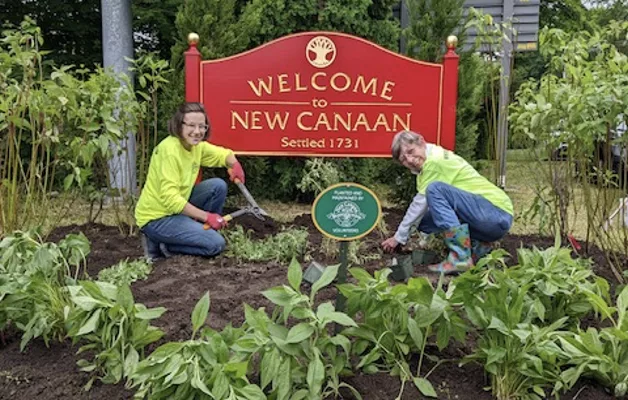
In 1968 midcentury modern architect Richard Foster designed The Round House in Wilton for his own family, a house also known as The Spaceship House or The Circambulant House, one which rotates fully on its axis once every 45 minutes, the first rotating house in the world.
Melissa and I had the pleasure of touring this masterpiece of architecture and technology with The Glass House’s Grainger Society on Saturday, the first group tour since its recent restoration. (I can’t say enough fine things about The Glass House and what they do for the New Canaan midcentury-modern-loving community.)
Who is Richard Foster? He was Philip Johnson’s first assistant on the Seagram’s Building (1957) and later Johnson’s partner, a frequent collaborator for decades until his death in 2002.
The house is first an engineering marvel, borrowing from the technology of battleships and cranes, ball bearings and gears to spin the entire 6,000 pound house using a tiny 1.5 hp motor. Consider the challenge of water pipes, waste pipes, electrical and communication wires in a moving house, here solved with ingenious concealed system of trolleys and troughs. I wondered if Foster got inspiration from his work with Johnson on the 1964 New York World’s Fair, a time when Bell Labs introduced the first Picturephone (Facetime!), IBM introduced the computer, Ford introduced the Mustang and Disney gave us Audio-Animatronics. Innovation was certainly in the air, but it was Foster and partner Johnson who contributed the most iconic building at the fair, the New York State Pavillion, We saw it in Marvel’s Iron Man 2. You can see parts of the Pavilion in the Round House.
Originally designed on a 3.83-acre site with breathtaking views of the distant hills, valley and reservoir, the Round House site was subdivided into three lots at some point, compromising the aesthetic. My mother, the realtor, touring the property in 2010 complained, “No longer original, and it’s a shame such a house shares a driveway with and is crowded by its neighbors.” Well, mom, I’m pleased to report the current owner has solved that, turning back time by purchasing the adjacent properties to double the footprint, replanting and improving on the original views. We parked in a field and approached the house through a wildflower meadow. The pool and pool house are extraordinary, and I couldn’t see a neighbor in any direction. Inside, the restorations are better-than-original, but in the spirit of the original.
The owners hired renowned landscape architect Daniel Morrison to do something really special: replace the suburban lawns with wildflower and native plant gardens and re-unifies the three properties, but preserve their privacy. I told you the approach was special, but the concept is complete, extending to all three houses. The plants are native, the gardening sustainable, and the power for it all provided by solar panels. It takes a whole other layer of skill, and dedication to improve upon a thing of beauty, with its history, in a sustainable, sensitive way.
A theory: people who appreciate innovation and fine engineering love vintage cars. I was not disappointed. In the garage I noticed a Citroen SM, Motor Trend’s Car of the Year for 1972, itself a marvel of hydropneumatics engineering, famous for travelling comfortably for hours at 124 mph but with the shortest stopping distance of any car of the time. Tucked in another corner of the property was a vintage 1960’s Airstream trailer, fitting right in.
It occurs to me maybe the Round House was an early “smart home” in an age before computers and disposable tech. When the morning sun gets in your eyes, rotate the house. Feeling chilly? Rotate it back. Today’s definition of smart home usually describes homes that can be controlled remotely. I say it is more important that the house do smart things when I’m in it rather than remotely controlling it when I’m not. Making better use of passive solar was a prescient first step.
When the best design for themselves we get Philip Johnson’s Glass House (1945-49), the Noyes House 2 (1954), the Breuer House (1947), the Gores House (1948) some of the purest expressions of the mid-century movement: flat-roofed, of glass and stone, all angles, very masculine. A few years later they give us a little bit of curve on the backside of Frank Lloyd Wright’s Rayford House (1956), the curved roofs of Johansen’s Bridge House (1956), Walter Stewarts Market (1957), the parabolic roof of the Evans House (1960) and Alan Gelbin’s Luthold House (1966). But, they were just teasing us. The Round House was not only the first round house, the purest expression of the technology and aesthetic of 1968, but it has aged well, now representing the best of 2024. What makes it special? Technology aside, there are design innovations worth noting. First, by elevating the house off the ground Foster gave us single level living in the air. Second, the unbroken span of curved glass around the perimeter – brilliant for form and function. Third, the exterior wraparound deck blurs the line between inside and outside. Fourth, the use of cedar shingles up the “stalk” and continuing to the underside of the house felt very organic and earthy, tree-like, as opposed to the stucco, glass and steel of the Harvard Five. Fifth, the patio beneath the house is made of a thousand small Belgian blocks radiating outward, a mosaic effect that plays with the architecture of the house. I could go on but suffice it to say the Round House is more than an interesting historical artifact, it is the complete package. If you want to learn, and see great architecture, contact the Glass House.
Notes from the Monday meeting. Looking at the first 6 months of the year: while the total volume of sales in New Canaan ($270mm) has increased +12.9% year over year, we are 35% ahead of our last pre-pandemic year, 2020 ($199mm). Darien, with less than half the inventory (34 homes for sale) of New Canaan (74) reports total dollar volume is down -40.3% ($182mm) and down -20% since June 2020.
John Engel and Melissa Engel are Realtors with The Engel Team at Douglas Elliman, and they are wearing socks this week during the final weeks of renovation at their antique home. Last week the floors were refinished. Today the kitchen cabinets and powder room sinks will be installed. Living through a renovation can be hard, so a quick shout-out to our contractor, Charles Anello. He gets an A+





